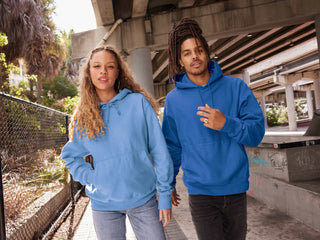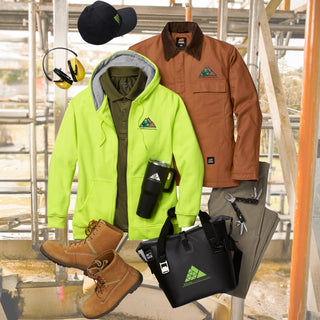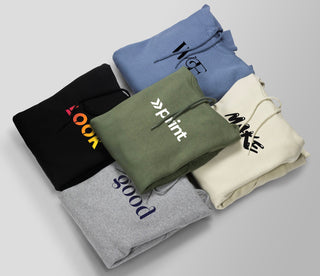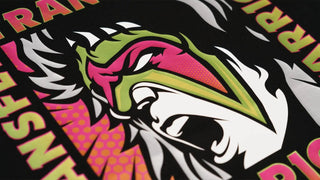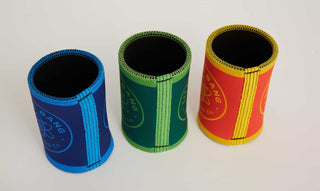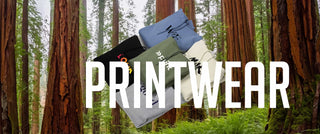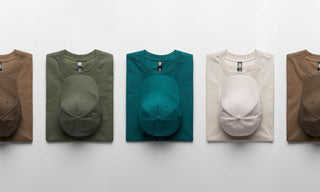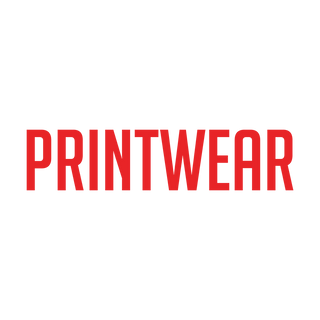A Guide to Quality T-Shirt Prints
In the realm of Printwear, not all file types are born equal. One of the most daunting challenges for achieving a top-notch, successful t-shirt print is dealing with low-resolution art files. It's a struggle our Art Department encounters frequently, right up there with navigating copyright issues and deciding what's on the lunch menu.
We’ll demystify the characteristics of the two primary file types and clarify the differences between them, with some examples. We delve into why some fare better than others and provide a succinct rundown of recommended file types alongside those best to steer clear of, if at all possible.
The Quest for the Optimal File Type
When it comes to printing, there exist two main categories of image files: vector and raster (also known as bitmap). Among these, the vector file stands tall as the pinnacle of quality and optimal format. It consistently yields the finest results, with few exceptions. Noteworthy vector file types encompass AI, EPS, and PDF.
Raster files, while still invaluable—especially for photographic images—require stringent parameters to ensure optimal results. They necessitate high-resolution with minimal compression. Hence, it's imperative to emphasize that with raster files, it's not merely the file type that dictates quality, but rather the file's overall fidelity.
We work with raster image files everyday and they generally print OK, if they are 300dpi and large enough so they avoid jagged edges when enlarged and sized. Saying that, vector files are the preference for screen printing and garment decoration since they are infinitely scalable and look the exact same at any size.
The Perils of Problematic Files
Low-resolution and heavily compressed raster images sourced from the web often pose significant challenges. They demand additional effort to ready them for printing and occasionally necessitate recreation. We'll guide you through evaluating your files for quality. But first, let's dissect the disparity between the two dominant file types.
Deciphering Raster vs. Vector
A vector graphic is essentially defined by mathematical points, whereas a raster graphic is comprised of pixels. Each point in a vector file, along with its relational positioning, defines the contours and forms of graphic elements. Additional data points encompass colors, gradients, text, and effects.
The defining feature of vector files, making them indispensable for printing, is their infinite scalability. You can resize these images to any extent without sacrificing quality—a feat unattainable with raster files.
Furthermore, vector graphics boast smaller file sizes compared to their raster counterparts. This distinction stems from the fact that raster files must store data for each pixel, whereas vector files only necessitate storing points defining objects.
Consider this analogy: Saving a raster file equates to memorizing an entire book word for word, whereas saving a vector file is akin to memorizing just the summary and page count. As the size of a raster image increases, so does its file size, exponentially so. Conversely, a vector file maintains consistent file size regardless of image dimensions, courtesy of its unchanging mathematical formula.
Both vector and raster (or bitmap) files exhibit versatility in their various forms. Most graphics programs afford users the liberty to save images in a diverse array of file types. Below, we outline the principal file types for each format:

Vector File Formats
Vector file types can assume compound forms, meaning they may contain raster files. However, a vector file can house raster files but not vice versa. It's commonplace for vector files to incorporate photographic elements or gradients, yet the layout, shapes, and type remain in vector form. Here are the three most prevalent vector files favored for printing:
- PDF (.pdf): Renowned for its universal compatibility, Portable Document Format retains original fonts and layout across diverse operating systems.
- EPS (.eps): Encapsulated PostScript stands as a standard vector file type, renowned for its self-contained nature, making it instantly deployable.
- AI (.ai): Adobe Illustrator's native file format, esteemed for its professional pedigree and wide-ranging capabilities. For those seeking a budget-friendly alternative, Inkscape emerges as a viable option.
The optimal vector file type hinges on myriad factors, including intended use, recipient preferences, and system compatibility. However, if versatility reigns supreme, PDF emerges as the frontrunner.
Pro Tips for Vector Files
Two recurring challenges warrant attention when it comes to vector files:
- Font Outlines: Ensure fonts are outlined to mitigate compatibility issues. Illustrator users can achieve this by selecting all text and opting for "Create Outlines" under the "Type" menu. If a font is not in outline form, reproducing it will require the actual font. An outline is completely portable and doesn’t require the font.
- Placed Files vs. Linked Files: When integrating raster files into a vector document, beware of inadvertently "linking" files instead of placing them. Failing to include linked files with the main document renders them unusable. Always uncheck the "link to" box when placing a file.

Raster File Formats
Raster files, colloquially known as bitmaps, reign supreme as the predominant image file category. The lion's share of web-based files falls within this domain. Technically, a bitmap serves as a grid of pixels, storing information pertaining to position, brightness, and color.
Here are the top three raster file types preferred for printing:
- JPEG: Predominantly tailored for encoding photographs, Joint Photographic Experts Group format excels in rendering rich colors and gradients. However, its compression algorithm inevitably incurs data loss with each save.
- TIFF: Targeted Image File Format, lauded for its impeccable compression, enjoys widespread adoption among photographers and graphic designers for its capacity to retain high quality.
- PSD: Adobe's proprietary Photoshop document format, revered as an industry standard for graphic design. Synonymous with digital image manipulation, Photoshop remains unparalleled in its domain.
Raster File Pro Tips
Raster files, owing to their richer data density, necessitate meticulous attention to resolution and compression settings. These two parameters wield profound influence over image quality, surpassing the significance of file type.
Resolution: A fundamental metric indicative of an image's detail, resolution denotes the number of pixels per inch (ppi) or dots per inch (dpi). For optimal printing results, aim for a minimum resolution of 300 dpi at full size.
Compression: Tread cautiously when compressing images to minimize artifacts and preserve image quality. Opt for "lossless" compression formats like TIFF or PNG to safeguard image fidelity.
Converting File Formats
While converting a vector file to raster is straightforward—simply rasterize it—converting a raster file to vector presents a more formidable challenge. However, equipped with the right tools and techniques, it's eminently feasible.
Raster to Vector: Leverage specialized software like Vector Magic or Adobe Illustrator's Live Trace feature to convert raster images to vector format. Exercise trial and error to fine-tune settings and achieve desired outcomes.
Vector to Raster: Employ graphic design software to export vector files into raster formats such as PSD, PNG, or JPEG. Various converter apps cater to diverse conversion needs, ensuring seamless interoperability across platforms.
Seeking Assistance
For those grappling with file format conundrums, fret not — the Printwear Art Department stands ready to assist. Armed with expertise and adeptness, we navigate these intricacies daily, offering basic image repair services at low or minimal additional cost of an art fee. Whether liaising with your sales rep or appending a note to your online order, entrust Printwear to execute your vision flawlessly. Simply assemble your order via our intuitive Design Studio, and leave the rest to us.
About Printwear
Printwear.io is your one-stop shop for turning ideas into impressive realities on anything from apparel and drinkware to bags and notebooks. Printwear uses cutting-edge decoration methods to make your designs pop, offering a variety of services including:
- Custom Apparel: Create branded t-shirts, hoodies, hats, and more.
- Promotional Products: From bags and blankets to pens and notebooks, Printwear.io helps you promote your brand or create personalized gifts.
- Design Services: Need help with your design? Printwear.io's team can guide you.


